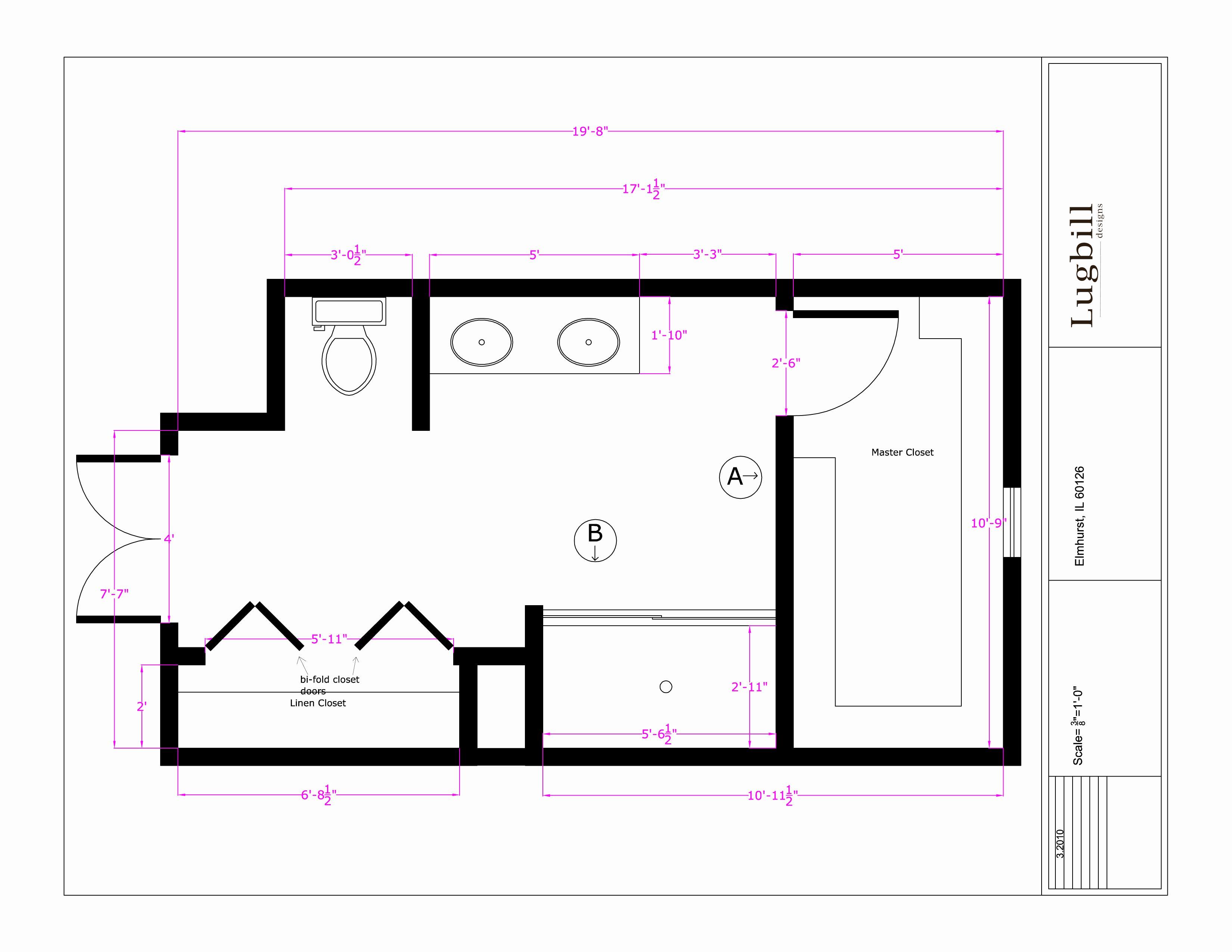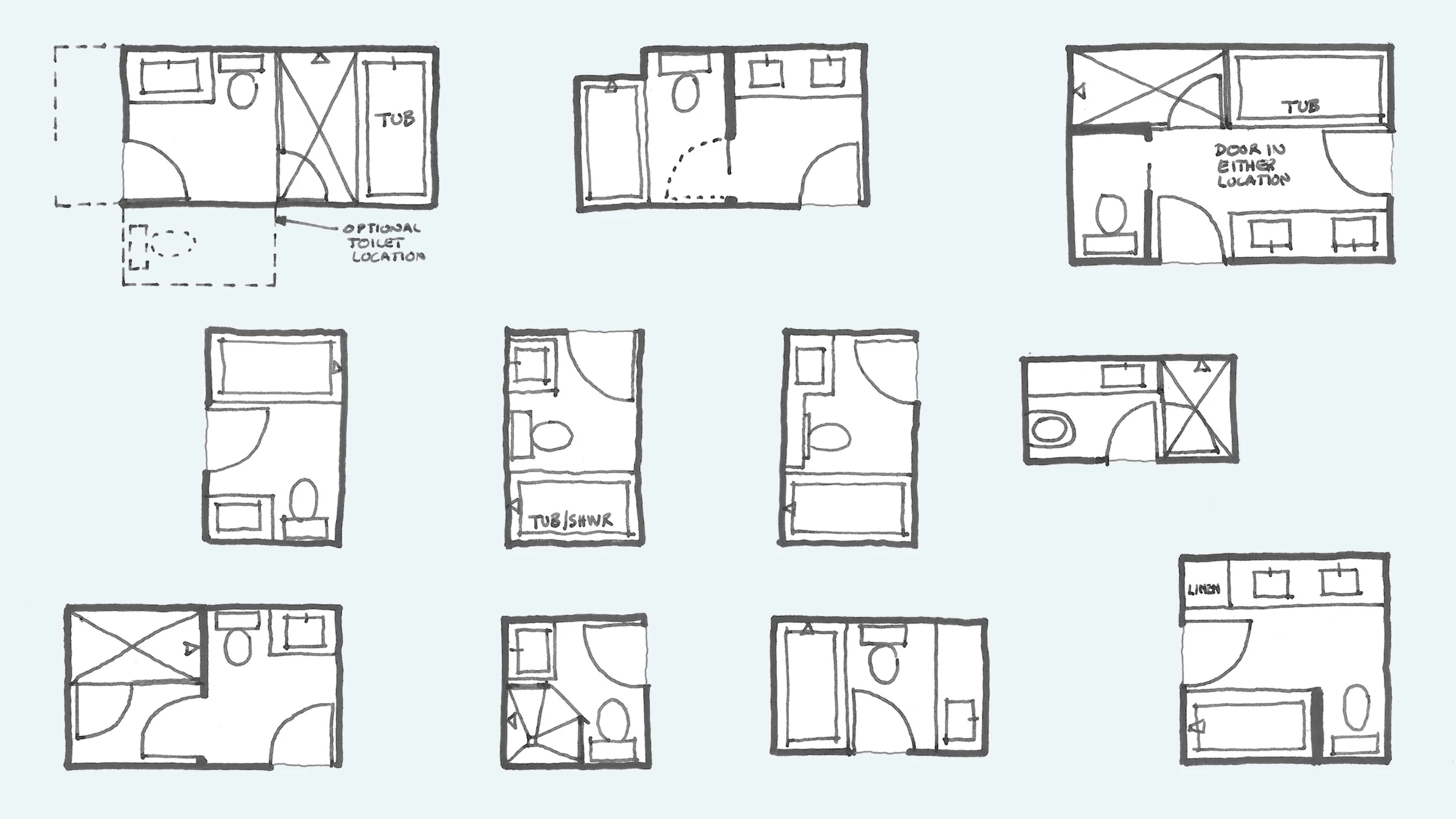Bathroom Floor Plan Essentials
A bathroom floor plan serves as a blueprint for the design and construction of a bathroom, outlining the layout, dimensions, and placement of fixtures. It is a crucial document for contractors, plumbers, and designers, ensuring the functionality and aesthetic appeal of the space.
Standard Components
A bathroom floor plan typically includes essential components that define the functionality and layout of the space. These components are:
- Walls and Doors: These elements define the boundaries of the bathroom and indicate the location of entrances and exits.
- Fixtures: This category encompasses all the essential components of a bathroom, such as the toilet, sink, bathtub or shower, and any additional features like bidets or towel warmers.
- Dimensions: Accurate measurements are crucial for ensuring proper placement and functionality of fixtures and ensuring sufficient space for movement.
- Materials: The floor plan should indicate the materials used for flooring, walls, and countertops.
- Lighting: The location and type of lighting fixtures are indicated on the plan.
- Ventilation: The floor plan should include the location of exhaust fans and other ventilation systems.
Bathroom Fixtures and Dimensions
The dimensions of bathroom fixtures are crucial for ensuring their proper functionality and comfortable use. Here is a list of common bathroom fixtures and their typical dimensions:
- Toilet: The average toilet bowl is 28-30 inches wide and 30-32 inches deep. The height of the toilet seat should be 15-18 inches.
- Sink: A standard bathroom sink is 21-24 inches wide and 18-20 inches deep. The height of the sink countertop is typically 34-36 inches.
- Bathtub: Bathtubs come in various sizes, but a standard bathtub is 60-72 inches long and 30-36 inches wide. The depth of a bathtub is typically 16-20 inches.
- Shower: A standard shower stall is 36-48 inches wide and 36-48 inches deep. The height of the shower head is typically 80-84 inches.
- Bidet: A bidet is typically 18-24 inches wide and 16-20 inches deep. The height of the bidet seat is usually 16-18 inches.
Accessibility Features
Incorporating accessibility features in bathroom floor plans is crucial for creating inclusive spaces that cater to people with disabilities. These features enhance the usability and safety of the bathroom for everyone.
- Grab Bars: These are essential for providing stability and support for users who may have difficulty maintaining balance. They are typically installed near the toilet, shower, and bathtub.
- Roll-In Showers: These showers have a barrier-free entry, allowing wheelchair users to easily access the shower area.
- Accessible Toilets: These toilets are typically higher than standard toilets, making them easier to use for individuals with mobility challenges.
- Lever Handles: Lever handles on faucets and shower controls are easier to operate for people with limited hand dexterity.
Creating Functional Bathroom Layouts: Bathroom Floor Plans With Measurements

A well-designed bathroom layout is crucial for both functionality and aesthetics. It ensures efficient use of space, comfortable movement, and a visually appealing environment. This section delves into the key considerations for creating functional bathroom layouts, exploring popular layout examples and incorporating accessibility features.
Traffic Flow and Space Optimization, Bathroom floor plans with measurements
Effective traffic flow within a bathroom is essential for creating a user-friendly experience. The ideal layout minimizes the chance of collisions and maximizes the utilization of available space.
* Define Primary and Secondary Zones: Identify the primary zones in the bathroom, such as the shower, toilet, and sink. These zones require adequate space for movement and should be arranged strategically. Secondary zones, such as storage areas, should be located in a way that doesn’t hinder primary movement.
* Maintain Clear Pathways: Ensure that clear pathways exist between primary zones, allowing for comfortable movement without obstruction. This can be achieved by strategically placing fixtures and furniture.
* Consider the ‘Golden Triangle’: The “Golden Triangle” concept, commonly used in kitchen design, can be applied to bathrooms. This refers to the arrangement of the sink, toilet, and shower in a triangular shape, optimizing movement and access.
* Optimize Space with Furniture: Utilize furniture strategically to create functional spaces within the bathroom. For example, a vanity with built-in storage can maximize space while providing a dedicated area for personal items.
* Vertical Storage: Maximize vertical space with tall cabinets or shelves to store toiletries, towels, and other bathroom essentials.
Popular Bathroom Layouts
Several popular bathroom layouts cater to different bathroom sizes and styles.
* Single-Vanity Layout: This is the most common layout, suitable for small to medium-sized bathrooms. It features a single vanity with a sink, a toilet, and a shower or bathtub.
* Double-Vanity Layout: This layout is ideal for larger bathrooms, offering separate vanities for multiple users. It typically includes a shower or bathtub, a toilet, and ample storage space.
* Walk-in Shower Layout: This layout features a spacious, barrier-free shower, often favored for accessibility and modern aesthetics. It can be combined with a single or double vanity and a toilet.
* Jack and Jill Bathroom: This layout is commonly found in homes with multiple bedrooms, featuring a shared bathroom with two entrances, each accessible from a separate bedroom.
* Ensuite Bathroom: An ensuite bathroom is directly connected to a bedroom, providing a private and convenient bathroom experience.
Designing an Accessible Bathroom
Creating an accessible bathroom is crucial for individuals with disabilities or mobility limitations.
* Wheelchair Accessibility: Ensure sufficient clearance for wheelchair maneuvering, particularly around the toilet, shower, and sink.
* Grab Bars: Install grab bars near the toilet, shower, and bathtub to provide support and stability.
* Low-Threshold Showers: Eliminate shower thresholds to allow for easy wheelchair access.
* Height-Adjustable Toilet: Consider a height-adjustable toilet for greater comfort and accessibility.
* Accessible Sink: Install a sink with an accessible height and ample clearance underneath for wheelchair users.
* Non-Slip Surfaces: Utilize non-slip flooring and shower surfaces to prevent falls and injuries.
Bathroom Floor Plan Resources

Creating a bathroom floor plan is crucial for planning a renovation or new construction project. It allows you to visualize the space, experiment with different layouts, and ensure that everything fits comfortably and functionally. There are numerous online resources and tools available that can help you create professional-looking bathroom floor plans with ease.
Online Resources and Tools
The availability of online resources and tools has revolutionized the process of creating bathroom floor plans. These platforms offer a wide range of features, from basic floor plan creation to advanced design capabilities.
- Floorplanner: This platform offers a user-friendly interface and a wide range of templates, making it suitable for beginners. You can create 2D and 3D floor plans, add furniture, and customize the design to your preferences. It also provides a feature to share your plans with others.
- RoomSketcher: RoomSketcher is another popular option that provides a balance between simplicity and functionality. It allows you to create floor plans, add furniture, and even create 3D visualizations. It also offers a free version with limited features and paid subscription options for more advanced features.
- Sweet Home 3D: This free and open-source software offers a comprehensive suite of tools for creating 3D home designs, including bathroom floor plans. It allows you to import existing floor plans, add furniture and objects, and customize the design to your liking. It also offers a range of features for creating photorealistic visualizations.
- SketchUp: SketchUp is a powerful 3D modeling software that is widely used by professionals and hobbyists alike. It offers a free version with basic features and paid subscription options for more advanced capabilities. It allows you to create detailed 3D models of your bathroom, including fixtures, furniture, and finishes. It also provides a vast library of 3D models that you can import into your design.
- Autodesk Revit: Revit is a professional-grade BIM (Building Information Modeling) software that is widely used in the architecture, engineering, and construction industries. It offers a comprehensive set of tools for creating detailed 3D models of buildings, including bathroom floor plans. It allows you to create accurate and detailed plans, including dimensions, materials, and specifications. It also provides features for collaborating with other team members on the project.
Comparison of Bathroom Floor Plan Software
Choosing the right bathroom floor plan software depends on your individual needs and preferences. Here is a comparison of some popular options based on their features and benefits:
| Software | Features | Benefits |
|---|---|---|
| Floorplanner | User-friendly interface, 2D and 3D floor plans, furniture library, sharing options | Easy to use, suitable for beginners, affordable options, good for basic design |
| RoomSketcher | Floor plans, furniture library, 3D visualizations, free and paid options | Balance between simplicity and functionality, suitable for both beginners and experienced users, good for creating realistic visualizations |
| Sweet Home 3D | Free and open-source, 3D home design, furniture library, photorealistic visualizations | Cost-effective, comprehensive features, suitable for creating detailed designs, good for creating photorealistic visualizations |
| SketchUp | Powerful 3D modeling, free and paid options, extensive 3D model library, collaboration features | Suitable for both beginners and professionals, good for creating detailed 3D models, access to a vast library of 3D models |
| Autodesk Revit | Professional BIM software, comprehensive features, detailed 3D modeling, collaboration features | Suitable for professionals, good for creating highly detailed and accurate plans, advanced features for collaboration and project management |
Using Online Tools to Generate and Customize Bathroom Floor Plans
Online tools provide a user-friendly way to generate and customize bathroom floor plans. Here’s a general guide:
- Choose a tool: Select a tool based on your needs and budget. Consider factors like user interface, features, and pricing.
- Create a new floor plan: Start a new project and choose the dimensions of your bathroom. You can use existing measurements or enter them manually.
- Add walls and fixtures: Use the tool’s built-in tools to draw walls, doors, windows, and other fixtures. You can adjust the size, shape, and position of these elements to match your desired layout.
- Add furniture and objects: Select furniture and other objects from the tool’s library or upload your own. Place them in the plan to visualize the layout and ensure everything fits comfortably.
- Customize the design: Experiment with different colors, materials, and textures to personalize the design. You can also adjust the lighting and other design elements to create the desired ambiance.
- Save and share your plan: Once you are satisfied with the design, save the plan and share it with others. Some tools offer features for sharing plans online or exporting them in different formats.
